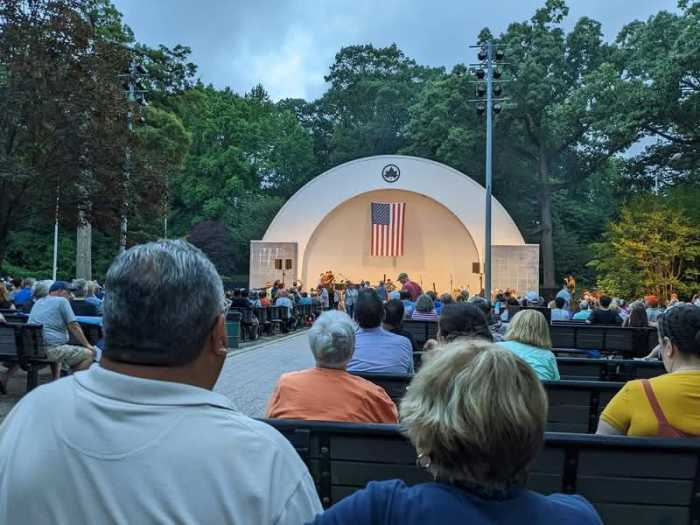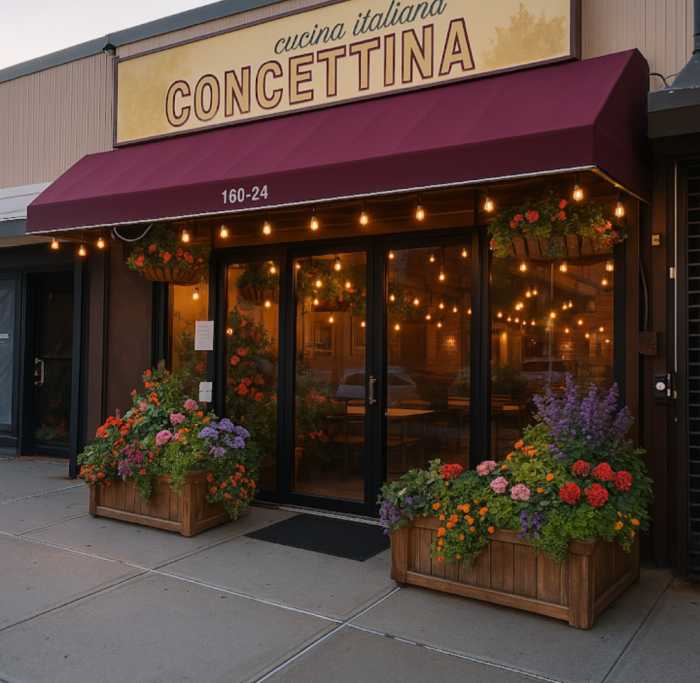By Kent Mancuso
Last Sunday afternoon I stepped from the brilliant sunlight on tree-lined street in Ozone Park into the CLC Community Center and was transported back into the late 1970s and into the blackest of murder tales ever conceived as the Spotlight Players presented Ira Levin’s 1978 thriller, “Deathtrap.”
At it’s worst, “Deathtrap,” is a shabby little shocker that painfully exploited the sexual revolution of the 1970s — namely, the growing awareness of the prevalence of homosexuality in America, right in cozy Connecticut suburbs. I say “painfully” because, as was also prevalent in films at the time, homosexuals are presented as psychotic killers, twisted beings with no redemption — light years away from Greg Kinnear’s more realistic portrait in “As Good as It Gets.”
At it’s dark best, “Deathtrap” is a gripping portrait of a soul in hell, the anguished Sydney Bruhl, an aging man caught in a loveless marriage to a wealthy woman, but who sees the dawn of a new life in the guise of one of his male students at a seminar, Clifford Anderson. He is willing to sacrifice everything at one desperate chance at happiness with Clifford, regardless of the consequences to himself or his wife, Myra. Of course, Thomas Mann (and Lucino Visconti) did it all before in “Death in Venice,” but that would never play on Broadway with its lust for blood and sex.
In 1978, the play became an instant success. People thronged to see the gay guys slam-dunk each other in a sadomasochistic blood bath unlike any thing since the days of Nero. Sidney Lumet made a film of it with Michael Caine and none other than “Superman” himself, Christopher Reeve. Since then it has played in professional and community theater revivals around the country, several in Queens in the past decade — though the Spotlight production is the first I’ve seen here since becoming a Queens resident.
How can you bring as twisted and violent a tale as “Deathtrap” into safe and polite Queens neighborhoods? Generally, as I’ve seen in other parts of this country over the years, the trick is to walk a middle road — focusing on Sidney’s gory collection of weapons and on he sudden twists in the characters’ apparent motives, and stay as far away as the script will allow from things sexual. That is exactly the road that Spotlight took in this production. And although I can never understand how an audience can buy into a story based on sordid sexuality when no sexuality is presented, that is exactly what the Spotlight audience did.
No doubt, director Joe Riley, producer Holly Gendron and a team of prop people and a tech crew from community theater heaven achieved a technical wonder on the CLC stage. The grand interior of what is supposed to be a converted farmhouse in Fairfield county, with its hunter green walls and unfinished wood beams, was magnificent, complete with a staircase in the rear, a flagstone fireplace, and sliding doors revealing the paneled side of the main house. The prop people went to town to deck the workroom of mystery playwright Bruhl with a host of weapons from his plays and his sadistic personal collection, with maces, swords, guns, and crossbows to spare. The shocking killings in both acts and thunder-and-lightning effects in act two were carefully mounted for maximum effect, and the audience was sitting at the edge of its seat for most of the show.
Spotlight was fortunate in luring W. Gordon Innes from his Parkside Players roots in Forest Hills to play Sidney Bruhl. Innes has a powerful basso voice and projects his lines with grandiose austerity, a trademark that suits many of the roles I have seen him tackle at Parkside, though on occasion he has bulldozed parts meant for more meek or sensitive personalities such as in “A Man for All Seasons” last year. As Sidney Bruhl, his grim demeanor is right at home, striking bitterly sarcastic, self-deprecating pose from which he never strayed through to the end. Never a line was missed, never a foot was placed in the wrong spot, with impeccable timing and splendid overall rhythm in this physically demanding part.
I could not help wonder, however, why he and his director could not confront the many other faces of this superbly written part. There were almost no transitions — from the rather sad but jolly husband to the sweating demon to the anguished soul at the end. The moment of discovery, when he realizes he was deceived as he flips through his partner’s script, was almost tossed away with just a grimmer facial expression than before. There was hardly any desperation or anguish at the denouement. In fact, his desperation should have been evident since it precipitates the carelessness that leads to his own demise. And of course, his passion for his partner was barely hinted at, in the broadest of strokes.
As Clifford Anderson, Carl Lieberman is truly to be proud of never faltering a line or stage moment in this enormous part. However, Clifford is among the blackest of villains in all melodrama, setting into motion the ugliest of crimes, and never once did I sense anything more but a well-spoken young man trying to write a play. “Deathtrap” is all about two people seducing each other — one for sex and the other for power and fame. I felt no seduction going on. In the blackest of moments, when Clifford has his partner handcuffed to a chair and vents the blackest of imprecations, he seemed to be “sort of” angry. And the “pretty face” line was just too coy to be taken seriously.
As Bruhl’s hapless wife Myra, Kim Riley needed to project her voice, as well as to paint a darker picture of a anxious and mistrusting wife. Her director husband might have better helped her pace the mounting hysteria that is essential to her character. In fact, even at her bloody confrontation with Clifford I felt nothing more than a whimper. Certainly we don’t want the overblown Dyan Cannon treatment from the film, but Dyan was far more on the mark than Riley’s portrayal.
As the psychic, Helga Tenn Dorf, Michelle Harber was hokey rather than comic. The humor should have come from her character’s eccentricity and from the sadistic touch of her confusion rather than from an awkwardly assumed accent — and frankly, she should have woven a kind of eerie spell over the proceedings, since her Cassandra like predictions all came true.
George King was most impressive as the family attorney. He was able to pack a bagful of transitions within just the few moments the script gives him on stage — from the concerned lawyer, to the sneaky and suspicious friend, to the avaricious wanna-be playwright at the play’s conclusion. He had all the charm and style that Sidney lacked at the opening of the play — and for one brief moment I wondered what this production might have been like if the two actors had traded roles. Hmmm.
There are two weekends left to the run. Anyone interested in a classy production of one of America’s most renowned shockers might get over to the CLC Community Center on 101st Ave and 86th Street in Ozone Park next Friday and Saturday Oct. 4, 5, 11 or 12 at 8 p.m. or Sunday Oct. 6 at 2 p.m. Call 843-2837 for reservations.
More mystery is afoot opening on Friday with “Murder Takes the Stage” with Theatre Time, 15-43 149th St. in Whitestone. Call 391-8697. Opening Oct. 11 at Douglaston Community Theatre is Agatha Christie’s rarely done “The Hollow,” at Zion Church, 44th Ave off Douglaston Parkway. Call 482-3332. And mark your calendar for three weekends beginning Oct. 25 as Theatre à la Carte presents Daphne du Maurier’s “Rebecca,” with a cast that reads like the Who’s Who of Queens Community Theatre. The theatre is at the Community Church of Douglaston, 39-50 Douglaston Parkway. Call 631-4092.


































